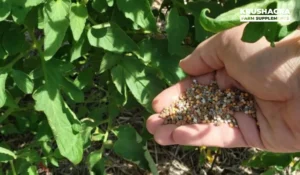Introduction:
Groundnuts, also known as peanuts, are an essential crop worldwide due to their nutritional value and versatile uses. To maximize groundnut yield, farmers constantly seek innovative and sustainable farming practices. One such practice is the utilization of nitrogen-fixing biofertilizers. These biofertilizers not only enhance soil fertility but also promote sustainable agriculture by reducing the reliance on synthetic nitrogen fertilizers. In this blog, we will explore the benefits of nitrogen-fixing biofertilizers and provide a comprehensive guide for farmers to maximize groundnut yield using these organic alternatives.
Understanding Nitrogen-Fixing Biofertilizers:
Nitrogen-fixing biofertilizers are biological agents that can convert atmospheric nitrogen (N₂) into forms readily available for plant uptake, primarily ammonia (NH₃) or nitrates (NO₃⁻). These biofertilizers contain beneficial microorganisms, such as rhizobia bacteria, which form a symbiotic relationship with leguminous plants like groundnuts. Rhizobia colonize the roots of groundnut plants and form nodules, where they convert atmospheric nitrogen into a usable form, thus providing a natural and sustainable source of nitrogen.
Benefits of Nitrogen-Fixing Biofertilizers:
Enhanced Nitrogen Availability: Nitrogen is a vital nutrient for plant growth and development. By utilizing nitrogen-fixing biofertilizers, groundnut plants can access a constant and sufficient supply of nitrogen, leading to improved growth, increased biomass production, and enhanced yields.
Improved Soil Fertility: Nitrogen-fixing biofertilizers not only provide nitrogen to the plants but also enrich the soil with organic matter. This organic matter improves soil structure, water-holding capacity, and nutrient retention, leading to overall improved soil fertility and long-term sustainability.
Reduced Dependency on Synthetic Fertilizers: Synthetic nitrogen fertilizers, while effective, can have adverse environmental impacts. Nitrogen-fixing biofertilizers offer a sustainable alternative by reducing the reliance on synthetic fertilizers, minimizing nitrogen leaching into water bodies, and decreasing greenhouse gas emissions.
Cost-Effectiveness: Biofertilizers can be a cost-effective option for farmers, as they reduce the need for expensive synthetic fertilizers. Moreover, the use of biofertilizers promotes self-sufficiency by providing a renewable source of nitrogen without the need for constant reapplication.
Steps to Maximize Groundnut Yield with Nitrogen-Fixing Biofertilizers:
Select Suitable Biofertilizer Strains: Different strains of rhizobia bacteria are specific to particular legume crops. To maximize groundnut yield, farmers should identify and select the most suitable rhizobial strain for groundnut cultivation. Consulting with local agricultural experts or extension services can provide valuable guidance in this regard.
Seed Treatment: Before sowing groundnut seeds, it is crucial to treat them with the selected biofertilizer strain. The treatment involves coating the seeds with a biofertilizer inoculant, which contains a high concentration of rhizobial cells. This ensures efficient and consistent colonization of the groundnut roots by the nitrogen-fixing bacteria.
Proper Inoculation Techniques: When applying the biofertilizer inoculant, it is essential to follow proper inoculation techniques. These techniques may vary depending on the type of inoculant used. Some common methods include seed coating, seed soaking, or applying the inoculant directly to the planting furrow. Adhering to recommended application rates and guidelines is crucial for successful inoculation.
Optimal Soil Conditions: Nitrogen-fixing biofertilizers perform best under specific soil conditions. Ensure that the soil pH is within the suitable range for groundnut cultivation, typically between 6.0 and 7.0. Conduct a soil test to assess nutrient levels and adjust the soil pH if necessary. Additionally, ensure proper soil drainage to avoid waterlogging, as excessive moisture can inhibit the activity of nitrogen-fixing bacteria.
Adequate Crop Rotation: Crop rotation plays a significant role in optimizing groundnut yield with biofertilizers. Legume crops, such as soybeans or cowpeas, should be included in the crop rotation cycle. These crops have the ability to fix atmospheric nitrogen themselves, further enhancing soil fertility and providing a favorable environment for the growth of rhizobia bacteria.
Timely Application of Biofertilizers: To maximize the benefits of nitrogen fixation, it is crucial to apply the biofertilizer at the right time. Groundnut plants generally require a higher nitrogen supply during the early stages of growth and pod formation. Follow the recommended application schedule provided by the biofertilizer manufacturer or local agricultural experts to ensure optimal timing.
Proper Nutrient Management: While biofertilizers contribute to nitrogen availability, groundnut plants also require other essential nutrients for optimal growth. Monitor the nutrient requirements of the crop and supplement with appropriate organic or mineral fertilizers as needed. Ensuring a balanced nutrient supply promotes overall plant health and maximizes groundnut yield.
Regular Monitoring and Maintenance: Throughout the growing season, monitor the performance of groundnut plants and observe nodulation on the roots. Regular visual inspections can help identify any issues early on, allowing for timely interventions. Additionally, maintain proper weed control, irrigation, and pest management practices to create a favorable growing environment for groundnuts.
Conclusion:
Maximizing groundnut yield with nitrogen-fixing biofertilizers offers numerous benefits to farmers, including enhanced nitrogen availability, improved soil fertility, reduced dependency on synthetic fertilizers, and cost-effectiveness. By following the steps outlined in this farmer’s guide, farmers can optimize the use of biofertilizers and achieve higher groundnut yields while practicing sustainable agriculture. Embracing these organic alternatives not only benefits individual farmers but also contributes to environmental conservation and the long-term sustainability of groundnut farming.






